Aquantia Launch AQtion 5G/2.5G/1G Multi-Gigabit Ethernet Cards (NICs) for PCIe
by Ian Cutress on May 15, 2017 8:30 AM EST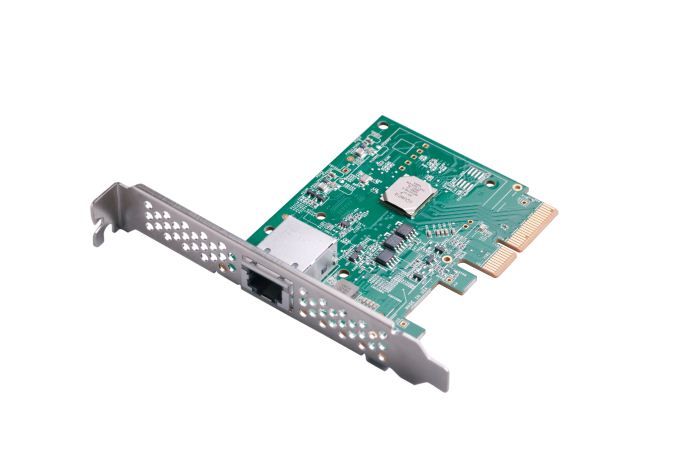
Late last year, Aquantia launched their range of multi-gigabit Ethernet controllers. These were controllers that could enable 1G, 2.5G and 5G connections over standard RJ45 connectors and Cat5e cabling. At the time, the two launched controllers were offered to OEMs to add into their custom motherboard builds, such as enterprise focused machines with a 5G office network in place. We have also seen motherboard manufacturers pick up the mantle, with consumer motherboards such as the ASRock Z270 SuperCarrier and the ASRock X370 Gaming, using the 5G Aquantia AQtion AQC108 chip.
Today's announcement cements Aquantia's lead in the multi-gigabit Ethernet space, despite already having an apparent 2 year lead over other rivals in this space (it helps that Aquantia helped define a major part of the 2.5G/5G specifications in the NBASE-T Alliance). Aquantia is launching two PCIe-based single-port network cards using their AQC108 and AQC107 controllers.
| Aquantia AQtion Multi-Gigabit NICs | ||
| Card | AQN-107 | AQN-108 |
| Controller | AQC-107 | AQC-108 |
| 100BASE-T | Yes | Yes |
| 1000BASE-T | Yes | Yes |
| 2.5GBASE-T | Yes | Yes |
| 5GBASE-T | Yes | Yes |
| 10GBASE-T | Yes | No |
| Ports | 1 | 1 |
| Price (from Aquantia) | $127 | $99 |
| Release Date | Soon | Soon |
| Potential Resellers | ASUS GIGABYTE |
? |
Both of these cards equip a system with a single port, with the AQC108 based card supporting BASE-T standards from 100M to 1G, 2.5G and 5G and uses a PCIe 3.0 x1 interface. The beefier AQC107 based card supports the same standards as well as 10G, and uses a PCIe 3.0 x4 interface (both cards will work down to PCIe 2.0 x1, with reduced data rates). Drivers for both cards will be available for the Windows 7/8/8.1/10 (also as part of the Windows Update solution) as well as varieties of Linux (3.10, 3.12, 3.2, 4.2 and 4.4).
The idea behind these cards is the same as other network cards - to be able to offer functionality without having to embed the controller on the motherboard or into a prebuilt/legacy system. In the consumer world, we have plenty of offerings of Intel and Realtek based gigabit Ethernet cards (even Killer NICs back in the day), and Intel commands the 10GBASE-T cards with its X540 and X550 series. Aquantia is hoping to shake up this market, particularly for businesses and end users willing to invest in 2.5G/5G infrastructure.
One of the big questions surrounding the transition to 2.5G/5G for home and SMB is infrastructure - making sure the network backbone, switches and access points are all capable. The major enterprise network players are already deploying multi-gigabit Ethernet networks to their customers, however it will be a bit longer before commercially available switches for consumers are available. One of the major drawbacks investing in 10GBASE-T in the home right now, aside from the $100-200 per port PCIe cards, is the cost of the switches. This is something Aquantia isn't doing directly, but we have been told that they are working with partners (the typical enterprise players at least) to solve. The depth of those solutions remain to be seen (we've been told similar by 10G switch vendors who had a different interpretation of 'mass market'), but ultimately for this technology to become ubiquitous, we need to see cheaper switches ($25/port), followed by cheap implementations, as we have seen in the last 15-20 years with gigabit Ethernet.
Final pricing is set at $99 and $127, with the 5G card being cheaper over the 10G card. Aquantia stated in the briefing that they are planning to sell the cards direct to consumers, or OEMs can brand the cards in their own style (eg imagine gaming based cards, as we've seen from Gigabyte already, or ASUS and their recently announced ROG Areion 10G card using the AQC107 chip) for their customers. It would be interesting to see if a manufacturer will offer a multi-port card by placing 2-4 chips on the same PCB, even if it requires a basic PLX switch. Four 1G/2.5G/5G/10G ports for $549, anyone?
Review samples are currently being circulated, and I'm discussing with Ganesh the best way to test them, especially as we don't have any 5G switch equipment. We're also looking at angles to test these ports as they appear on motherboards too. Aquantia expects the cards to be on shelves shortly, with branded cards to follow.


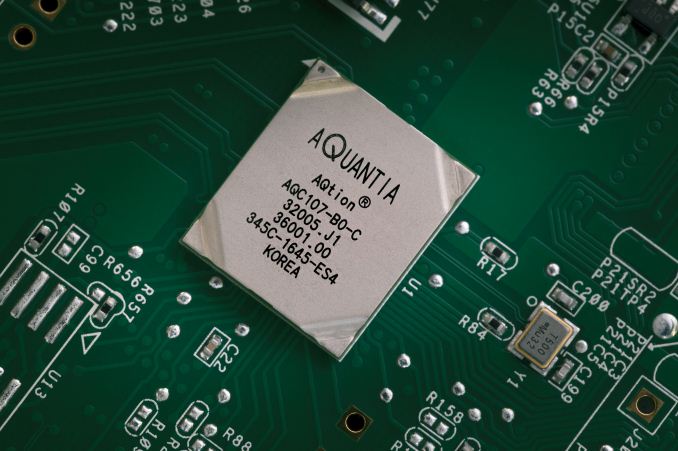
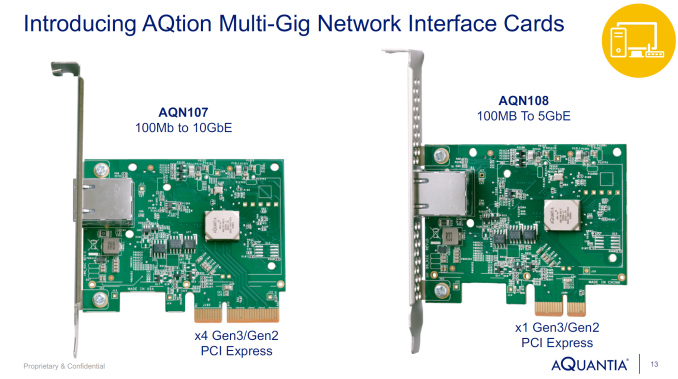
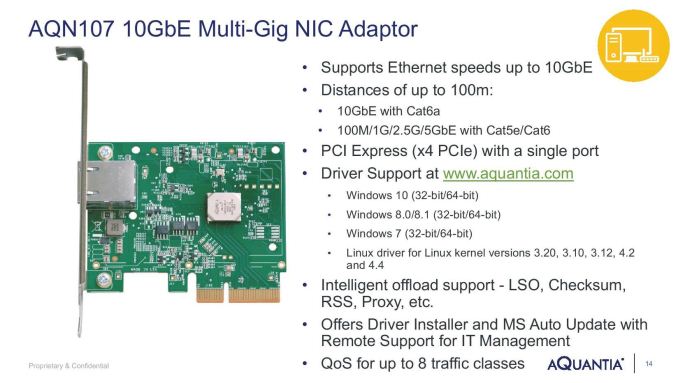
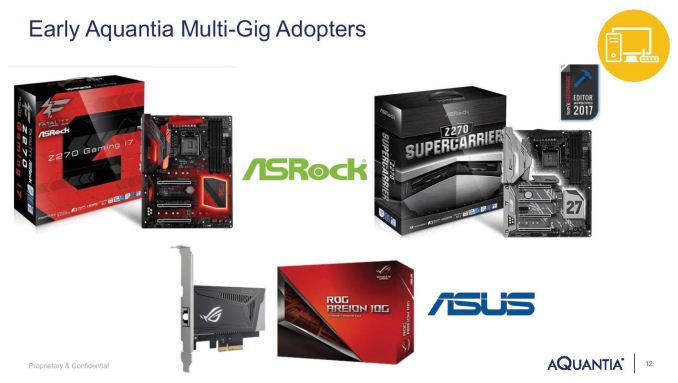
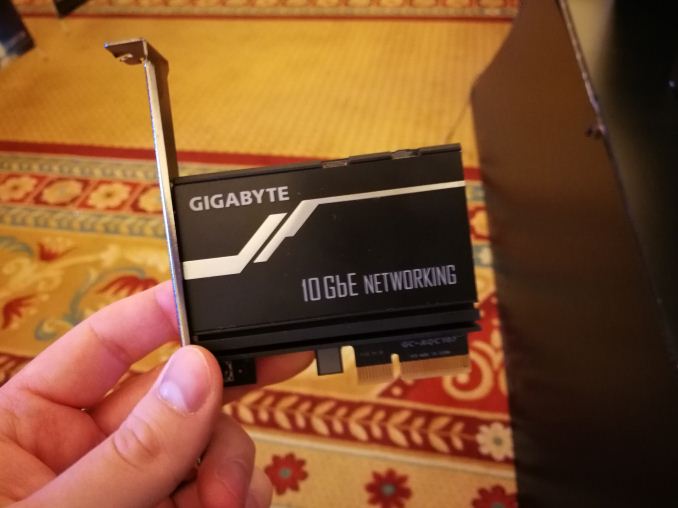




















33 Comments
View All Comments
chechito - Monday, May 15, 2017 - link
i think 99us per port for 5g ethernet is far from mass market, i think 60us is needed for nics and switches to make 5g ethernet ubiquitousone advantage is pciexpress 3.0 x1 capable enough for 5g ethernet
10g ethernet can wait for most mass market
i think vendors are trying to use 2.5g and 5g ethernet to promote 10g ethernet at almost the same cost, deniying the masses the access to 2.5g and 5g at cheap prices
thewishy - Monday, May 15, 2017 - link
I don't think 1ge is "Mass market" these days; most people use wifi... Even offices are going in that direction...It's only ever going to be an enthusiast / business solution.
chechito - Monday, May 15, 2017 - link
i think wired vs wireless topic is far from this discussionSpetsnazAntiVIP - Tuesday, May 16, 2017 - link
Cool let me know when they start offering a consumer 10 gbe switch for $100-$150 and I'll be the first to buy it.vailr - Monday, May 15, 2017 - link
Latest Aquantia drivers & discussion:station-drivers (dot) com /index.php?option=com_kunena&view=topic&catid=7&id=2520&Itemid=255&lang=en#14855
dgingeri - Monday, May 15, 2017 - link
Now if someone were to just release a reasonably priced switch for 5Gbe. That would be nice.Manch - Monday, May 15, 2017 - link
I haven't gone all wrecking crew in the house bc wireless is ehhh... acceptable and I cant justify drilling. As soon as they release 5GB switches, it will be time to bust out the drill and piss the wife off.Vatharian - Monday, May 15, 2017 - link
Ian: I think that may be important during tests: if that's possible please use both good quality cat 6e cables, and cheapest cat5/5e. If this tech is limited to 6/6e only (for meaningfull bumb ove 1GbE, there is little benefit for end-users.James5mith - Monday, May 15, 2017 - link
10GbE 5,8,16 port switches need to drop below $20/port to be feasible, and realistically to ~$10/port for them to fully replace aging 1GbE switches.I currently have a draw with a few spare 5 port and 8 port gigabit switches for when issues arise with a friend or coworkers network. Easier to troubleshoot. Until it makes financial sense to do that with 10GbE, it hasn't hit mainstream.
chechito - Monday, May 15, 2017 - link
keep in mind cheap port prices stay only on 5 and 8 ports switches, bigger switches offer more expensive cost per porti think 15 bucks per port on small switches of 5 and 8 ports for 2.5g is possible
30 bucks per port for 5.0g too
but the problem is the nics, we need 30 bucks nic en 2.5g and at least 60 bucks noc on 5.0g to make reacheable for many people
10 buck per port'?? i think not in this decade